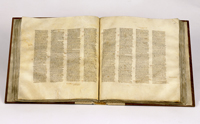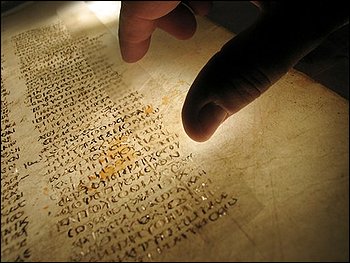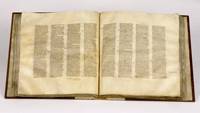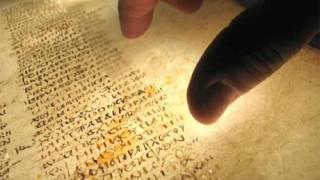World's oldest Christian Bible digitized
Source: washingtonpost.com
The Codex Sinaiticus Project: The surviving pages of the world's oldest Christian Bible have been reunited - digitally. The early work known as the Codex Sinaiticus has been housed in four separate locations across the world for more than 150 years. But starting Monday, it became available for perusal on the Web at www.codexsinaiticus.org so scholars and other readers can get a closer look at what the British Library calls a "unique treasure."
The surviving pages of the world's oldest Christian Bible have been reunited - digitally. The early work known as the Codex Sinaiticus has been housed in four separate locations across the world for more than 150 years. But starting Monday, it became available for perusal on the Web at www.codexsinaiticus.org so scholars and other readers can get a closer look at what the British Library calls a "unique treasure.""(The book) offers a window into the development of early Christianity and firsthand evidence of how the text of the Bible was transmitted from generation to generation," said Scot McKendrick, head of Western manuscripts at the British Library.
As it survives today, Codex Sinaiticus comprises just over 400 large leaves of prepared animal skin, each of which measures 15 inches by 13.5 inches (380 millimeters by 345 millimeters). It is the oldest book that contains a complete New Testament and is only missing parts of the Old Testament and the Apocrypha.

This undated picture made available by the British Library shows a reader examining a page from the earliest surviving Christian Bible. The British Library says the surviving pages of the world's oldest Bible have been reunited _ digitally. The library says the early Christian work known as the Codex Sinaiticus had been housed in four separate locations across the world for more than 150 years.
It became available Monday for perusal on the Web so scholars and others can get a closer look. The library says the work will allow scholars to further study the "unique treasure." The project united organizations from Great Britain, Germany, Russia and Egypt. Each possessed parts of the 1,600-year-old manuscript. They worked together to publish new research into the history of the Codex and transcribed 650,000 words during a four-year period. (AP Photo/The British Library)
The 4th-century book, written in Greek, has been digitally reunited in a project involving groups from Britain, Germany, Russia and Egypt, which each possessed parts of the 1,600-year-old manuscript.
They worked together to publish new research into the history of the Codex and transcribed 650,000 words over a four-year period.
The Codex was both a key Christian text and "a landmark in the history of the book, as it is arguably the oldest large-bound book to have survived," McKendrick said.
Codex Sinaiticus, which loosely translated means "the book from Sinai," was discovered at the Monastery of Saint Catherine at Mount Sinai by German Bible scholar Constantine Tischendorf in the mid-19th century. Much of it eventually wound up in Russia - just how exactly the British Library won't say, citing lingering sensitivity over the circumstances surrounding its removal from the monastery.
The British Library bought 347 pages from Soviet authorities in 1933. Forty-three pages are at the University Library in Leipzig, Germany, and six fragments are at the National Library of Russia in St. Petersburg. And in 1975, monks stumbled on 12 more pages and 40 fragments stashed in a hidden room at the monastery at Mount Sinai.
Juan Garces, the Codex Sinaiticus project manager, said putting the book online was a "definitely a historical moment."
"It's special because it's the oldest almost completely preserved bible," Garces said.
Garces said the only other Bible that rivals Codex Sinaiticus in age is the Codex Vaticanus, which was written around the same time but lacks parts of the New Testament.
"It's such an important book - that's why it should be accessible," Garces said. "If you would have liked to see it before you would have had to travel to four countries in two continents. If you want to see the manuscript right now all you have to do is go online and experience it for yourself."
On the Codex parchment leaves is written around half of the Old Testament and Apocrypha, the whole of the New Testament and two early Christian texts not found in modern Bibles. Most of the first part of the Bible manuscript - containing most of the so-called historical books, from Genesis to 1 Chronicles - is missing and presumed to be lost.
Garces said Codex Sinaiticus was handwritten by four scribes. Experts had previously believed there were only three, but researchers at the British Library looked at the script with high quality digital imaging that revealed the hand of a fourth penman.
"From Parchment to Pixel: The Virtual Reunification of the Codex Sinaiticus," an exhibit about the Bible's reunification process, opened at the British Library on Monday and runs until Sept. 7.
The digitized manuscript includes more than 800 pages and fragments, including the pages discovered in 1975 - published for the first time.
"There's a high demand," Garces said. "Our Web site has crashed because people want to look at it."
Article from: WashingtonPost.com
Related:
Codex Sinaiticus: text, Bible, book
Also Tune Into:
John Lash - Origin of Religion, Entheogens, Wasson & Black Magic Pharmacology
John Lash - The Discovery of the Eadwine Psalter (Subscription)






















